Anomalies of Brillouin Light Scattering in Selected Perovskite Relaxor Ferroelectric Crystals
Abstract
1. Introduction
2. Brillouin Scattering
3. Materials and Methods
4. Results and Discussion
4.1. Elastic Anomalies and Polarization Dynamics in PMT
4.2. Anomalous Behavior of Longitudinal Acoustic Phonons in PST
4.3. Brillouin Spectroscopy of Cubic–Tetragonal Structural Phase Transition in a 0.65PIN-0.35PT Single Crystal
4.4. Brillouin Light Scattering Studies of Acoustic Phonon Anomalies in SCT-0.03 Quantum Ferroelectrics
5. Conclusions
Author Contributions
Funding
Informed Consent Statement
Data Availability Statement
Acknowledgments
Conflicts of Interest
References
- Lines, M.E.; Glass, A.M. Principles and Applications of Ferroelectrics and Related Materials; Clarendon Press: Oxford, UK, 1977; pp. 24–58. [Google Scholar]
- Samara, G.A. Ferroelectricity Revisited-Advances in Materials and Physics. Solid State Phys. 2001, 56, 252–343. [Google Scholar]
- Hochli, U.T.; Maglione, M. Dielectric relaxation spectroscopy and the ground state of K1−xLixTaO3. J. Phys. Condens. Matter 1989, 1, 2241–2256. [Google Scholar] [CrossRef]
- Toulouse, J.; Pattnaik, R. Collective behaviours in disordered ferroelectrics KLT and KTN. J. Korean Phys. Soc. 1998, 32, S942–S946. [Google Scholar]
- Samara, G.A. Nature of the phase transition in KTaO3 with random site impurities. Jpn. J. Appl. Phys. 1985, 24, 80–84. [Google Scholar] [CrossRef]
- Viehland, D.; Jang, S.J.; Cross, L.E.; Wuttig, M. Freezing of the polarization fluctuations in lead magnesium niobate relaxors. J. Appl. Phys. 1990, 68, 2916–2921. [Google Scholar] [CrossRef]
- de Mathan, N.; Husson, E.; Calvarin, G.; Gavarri, J.R.; Hewat, A.W.; Morell, A. A structural model for the relaxorPb(Mg1/3Nb2/3)O3 at 5 K. J. Phys. Condens. Matter 1991, 3, 8159–8171. [Google Scholar] [CrossRef]
- Cross, L.E. Relaxor Ferroelectrics. Ferroelectrics 1987, 76, 241. [Google Scholar] [CrossRef]
- Knauss, L.A.; Wang, X.M.; Toulouse, J. Polarization-strain coupling in the mixed ferroelectric KTa1−xNbxO3. Phys. Rev. B 1995, 52, 13261–13268. [Google Scholar] [CrossRef] [PubMed]
- Sviteskiy, O.; Toulouse, J.; Yong, G.; Ye, Z.-G. Polarized Raman study of the phonon dynamics in Pb(Mg1/3Nb2/3)O3crystal. Phys. Rev. B 2003, 68, 104107. [Google Scholar] [CrossRef]
- Lushnikov, S.G.; Fedoseev, A.I.; Gvasalia, S.N.; Kojima, S. Anomalous dispersion of the elastic constants at the phase transformation of the PbMg1/3Nb2/3O3relaxor ferroelectric. Phys. Rev. B 2008, 77, 104122. [Google Scholar] [CrossRef]
- Doussineau, P.; Farssi, Y.; Frenois, C.; Levelut, A.; McEnaney, K.; Toulouse, J.; Ziolkiewicz, S. Dielectric study of the phase transition in K1−xLixTaO3. Europhys. Phys. Lett. 1993, 24, 415–420. [Google Scholar] [CrossRef]
- DiAntonio, P.; Vugmeister, B.E.; Toulouse, J.; Boatner, L.A. Polar fluctuations and first-order Raman scattering in highly polarisable KTaO3 crystals with off-center Li and Nb ions. Phys. Rev. B 1993, 47, 5629–5637. [Google Scholar] [CrossRef]
- Toulouse, J.; DiAntonio, P.; Vugmeister, B.E.; Wang, X.M.; Knauss, L.A. Precursor effects and ferroelectric macroregions in KTa1−xNbxO3 and K1−yLiyTaO3. Phys. Rev. Lett. 1992, 68, 232–235. [Google Scholar] [CrossRef] [PubMed]
- Nuzhnyy, D.; Bovtun, V.; Buixaderas, E.; Petzelt, J.; Savinov, M.; Kempa, M.; Pasciak, M.; Rafalovskyi, I.; ChelodPaingad, V.; Kuzel, P.; et al. Unusual dynamics of ferroelectric phase transition in K1−xLixTaO3 crystals. Phys. Rev. B 2022, 105, 184103. [Google Scholar] [CrossRef]
- Bianchi, U.; Dec, J.; Kleemann, W.; Bednorz, J.G. Cluster and domain-state dynamics of ferroelectric Sr1−xCaxTiO3 (x=0.007). Phys. Rev. B 1995, 51, 8737–8746. [Google Scholar] [CrossRef] [PubMed]
- Kleemann, W.; Albertini, A.; Kuss, M.; Lindner, R. Optical detection of symmetry breaking on a nanoscale in SrTiO3:Ca. Ferroelectrics 1997, 203, 57–74. [Google Scholar] [CrossRef]
- Bednorz, J.G.; Muller, K.A. Sr1−xCaxTiO3: An XY quantum ferroelectric with transition to randomness. Phys. Rev. Lett. 1984, 52, 2289–2292. [Google Scholar] [CrossRef]
- Ranjan, R.; Panday, D.; Lalla, N.P. Novel features of Sr1−xCaxTiO3 phase diagram: Evidence for Competing Antiferroelectric and Ferroelectric Interactions. Phys. Rev. Lett. 2000, 84, 3726. [Google Scholar] [CrossRef] [PubMed]
- Geneste, G.; Kiat, J.-M. Ground state Ca-doped strontium titanate: Ferroelectricity versus polar nanoregions. Phys. Rev. B 2008, 77, 174101. [Google Scholar] [CrossRef]
- Rischau, C.W.; Lin, X.; Grams, C.P.; Finck, D.; Harms, S.; Engelmayer, J.; Lorentz, T.; Gallais, Y.; Fauque, B.; Hemberger, J.; et al. A ferroelectric quantum phase transition inside the superconducting dome of Sr1−xCaxTiO3−δ. Nat. Phys. Lett. 2017, 13, 643–648. [Google Scholar]
- Viehland, D.; Jang, S.J.; Cross, L.E.; Wuttig, M. Deviation from Curie-Weiss behaviour in relaxor ferroelectrics. Phys. Rev. B 1992, 46, 8003–8006. [Google Scholar] [CrossRef] [PubMed]
- Viehland, D.; Li, J.F.; Jang, S.J.; Cross, L.E.; Wuttig, M. Glassy polarization behaviour of relaxor ferroelectrics. Phys. Rev. B 1992, 46, 8013–8017. [Google Scholar] [CrossRef] [PubMed]
- Moriya, Y.; Kawaji, H.; Tojo, T.; Atake, T. Specific heat anomaly caused by ferroelectric nanoregions in Pb(Mg1/3Nb2/3)O3 and Pb(Mg1/3Ta2/3)O3 relaxors. Phys. Rev. Lett. 2003, 90, 205901. [Google Scholar] [CrossRef] [PubMed]
- Cowley, R.A.; Gvasaliya, S.N.; Lushnikov, S.G.; Roessli, B.; Rotaru, G.M. Relaxing with relaxors: A review of relaxor ferroelectrics. Adv. Phys. 2011, 60, 229–327. [Google Scholar] [CrossRef]
- Toulouse, J.; Jiang, F.; Sviteskiy, O.; Chen, W.; Ye, Z.-G. Temperature evolution of the relaxor dynamics in Pb(Zn1/3Nb2/3)O3: A critical Raman analysis. Phys. Rev. B 2005, 72, 184106. [Google Scholar] [CrossRef]
- Sviteskiy, O.; La-Orauttapong, D.; Toulouse, J.; Chen, W.; Ye, Z.-G. PbTiO3 addition and internal dynamics in Pb(Zn1/3Nb2/3)O3 crystal studied by Raman spectroscopy. Phys. Rev. B 2005, 72, 172106. [Google Scholar] [CrossRef]
- Dul’kin, E.; Roth, M.; Janolin, P.E.; Dkhil, B. Acoustic emission study of phase transitions and polar nanoregions in relaxor-based systems: Application to the family of Pb(Zn1/3Nb2/3)O3 family of single crystals. Phys. Rev. B 2006, 73, 012102. [Google Scholar] [CrossRef]
- Roth, M.; Mojaev, E.; Dul’kin, E.; Gemeiner, P.; Dkhil, B. Phase transition at a nanometer scale detected by acoustic emission within the cubic phase Pb(Zn1/3Nb2/3)O3-xPbTiO3relaxor ferroelectrics. Phys. Rev. Lett. 2007, 98, 265701. [Google Scholar] [CrossRef]
- Dkhil, B.; Gemeiner, P.; Al-Barakaty, A.; Bellaiche, L.; Dul’kin, E.; Mojaev, E.; Roth, M. Intermediate temperature scale T* in lead-based relaxor systems. Phys. Rev. B 2009, 80, 064103. [Google Scholar] [CrossRef]
- Park, S.E.; Shrout, T.R. Ultra high strain and piezoelectric behaviour in relaxor based ferroelectric single crystals. J. Appl. Phys. 1997, 82, 1804–1811. [Google Scholar] [CrossRef]
- Cox, D.E.; Noheda, B.; Shirane, G.; Useu, Y.; Fujishiro, K.; Yamada, Y. Universal phase diagram for high-piezoelectric perovskite systems. Appl. Phys. Lett. 2001, 79, 400–402. [Google Scholar] [CrossRef]
- Yasuda, N.; Ohwa, H.; Kume, M.; Yamashita, Y. Piezoelectric properties of a high Curie temperature Pb(In1/2Nb1/2)O3-PbTiO3 binary system single crystal near a morphotropic phase boundary. Jpn. J. Appl. Phys. 2000, 39 Pt 2, L66–L68. [Google Scholar] [CrossRef]
- Setter, N.; Cross, L.E. The role of B-site cation disorder in diffuse phase transition behaviour of perovskite ferroelectrics. J. Appl. Phys. 1980, 51, 4356–4360. [Google Scholar] [CrossRef]
- Chu, F.; Reaney, I.M.; Setter, N. Spontaneous (zero-field) relaxor-to-ferroelectric phase transition in disordered Pb(Sc1/2Nb1/2)O3. J. Appl. Phys. 1995, 77, 1671–1676. [Google Scholar] [CrossRef]
- Chu, F.; Setter, N.; Taganstev, A.K. The spontaneous relaxor-ferroelectric transition of Pb(Sc0.5Ta0.5)O3. J. Appl. Phys. 1993, 74, 5129–5134. [Google Scholar] [CrossRef]
- Malibert, C.; Dkhil, B.; Kiat, J.M.; Durand, D.; Berar, J.F.; Spasojevic-de Bire, A. Order and disorder in the relaxor ferroelectric perovskite Pb(Sc1/2Nb1/2)O3 (PSN): Comparison with simple perovskites BaTiO3 and PbTiO3. J. Phys. Condens. Matter 1997, 9, 7485–7500. [Google Scholar] [CrossRef]
- Yasuda, N.; Ohwa, H.; Oohashi, J.; Nomura, K.; Terauchi, H.; Iwata, M.; Ishibashi, Y. The temperature and pressure dependence of the dielectric properties of disordered and ordered Pb(In1/2Nb1/2)O3 single crystals. J. Phys. Soc. Jpn. 1998, 67, 3952–3957. [Google Scholar] [CrossRef]
- Blinc, R.; Gregorovic, A.; Zalar, B.; Pirc, R.; Laguta, V.V.; Glinchuk, M.D. Nuclear magnetic resonance study of the relaxor ferroelectric Pb(Sc1/2Nb1/2)O3. J. Appl. Phys. 2001, 89, 1349–1354. [Google Scholar] [CrossRef]
- Laguta, V.V.; Glinchuk, M.D.; Bykov, I.P.; Blinc, R.; Zalar, B. NMR study of ionic shifts and polar ordering in the relaxor ferroelectric Pb(Sc1/2Nb1/2)O3. Phys. Rev. B 2004, 69, 054103. [Google Scholar] [CrossRef]
- Sivasubramanian, V.; Ganesamoorthy, S. Elastic behaviour and dynamical aspects of polarization in Pb(Mg1/3Nb2/3)O3 and Pb(Mg1/3Ta2/3)O3 studied by Brillouin spectroscopy. Eur. Phys. J. Appl. Phys. 2015, 69, 10701. [Google Scholar] [CrossRef]
- Ko, J.-H.; Kojima, S.; Lushnikov, S.G. Dynamic behaviours of Pb(Mg1/3Nb2/3)O3and Ba(Mg1/3Nb2/3)O3single crystals studied by micro-Brillouin scattering and dielectric spectroscopy. App. Phys. Lett. 2003, 82, 4128. [Google Scholar] [CrossRef]
- Shabir, G.; Kojima, S. Central peak and acoustic phonon anomalies of the relaxor ferroelectric lead magnesium niobate-lead titanate single crystal studied by the micro-Brillouin scattering. App. Phys. Lett. 2007, 91, 062911. [Google Scholar] [CrossRef]
- Ko, J.-H.; Kim, D.H.; Kojima, S. Central peak, acoustic modes, and the dynamics of polar nanoregions in Pb[(Zn1/3Nb2/3)1−xTix]O3 single crystals studied by Brillouin spectroscopy. Phys. Rev. B 2008, 77, 104110. [Google Scholar] [CrossRef]
- Tsukada, S.; Hikada, Y.; Kojima, S.; Bokov, A.A.; Ye, Z.-G. Development of nanoscale polarization fluctuations in relaxor based (1−x)Pb(Sc1/2Nb1/2)O3-xPbTiO3 ferroelectrics studied by Brillouin scattering. Phys. Rev. B 2013, 87, 014101. [Google Scholar] [CrossRef]
- Ahart, M.; Hushur, A.; Ping, Y.; Ye, Z.-G.; Hemley, R.J.; Kojima, S. Critical slowing down of relaxation dynamics near the Curie temperature in the relaxor Pb(Sc0.5Nb0.5)O3. Appl. Phys. Lett. 2009, 94, 142906. [Google Scholar] [CrossRef]
- Ko, J.-H.; Kim, D.H.; Tsukada, S.; Kojima, S.; Bokov, A.A.; Ye, Z.-G. Crossover in the mechanism of ferroelectric phase transition of Pb[(Mg1/3Nb2/3)1−xTix]O3 single crystals studied by Brillouin light scattering. Phys. Rev. B 2010, 82, 104110. [Google Scholar] [CrossRef]
- Tsukada, S.; Ike, Y.; Kano, J.; Sekiya, T.; Shimojo, Y.; Wang, R.; Kojima, S. Broadband inelastic light scattering of a relaxor ferroelectric 0.71Pb(Ni1/3Nb2/3)O3-0.29PbTiO3. Appl. Phys. Lett. 2006, 89, 212903. [Google Scholar] [CrossRef]
- Ko, J.-H.; Kojima, S.; Bokov, A.A.; Ye, Z.-G. Light scattering study of acoustic phonon modes and central peaks in Pb[(Mg1/3Nb2/3)0.45Ti0.55]O3 single crystals. Appl. Phys. Lett. 2007, 91, 252909. [Google Scholar] [CrossRef]
- Sivasubramanian, V.; Tsukada, S.; Kojima, S. Anomalous behaviour of acoustic phonon and central peak in Pb[(In1/2Nb1/2)0.65Ti0.35]O3 single crystal. J. Appl. Phys. 2009, 105, 014108. [Google Scholar] [CrossRef]
- Sivasubramanian, V.; Kojima, S. Brillouin scattering studies of acoustic phonon modes and central peak in single crystal Pb(Sc1/2Ta1/2)O3. Phys. Rev. B 2012, 85, 054104. [Google Scholar] [CrossRef]
- Sivasubramanian, V.; Subramanian, V.; Kojima, S. Classical ferroelectric like behaviour of highly ordered Pb(Sc1/2Nb1/2)O3 studied by dielectric and Brillouin scattering spectroscopy. Phys. Rev. B 2016, 93, 054115. [Google Scholar] [CrossRef]
- Kojima, S.; Ko, J.-H. Broadband micro-Brillouin scattering spectroscopy of Pb(B1/3B′2/3)O3 based relaxor ferroelectrics. Curr. Appl. Phys. 2011, 11, S22–S32. [Google Scholar] [CrossRef]
- Kojima, S.; Muhtar, A.; Sivasubramanian, V.; Volkov, A.A.; Ye, J.C. Precursor dynamics of Pb(B1/3B′2/3)O3-type relaxor ferroelectrics studied by micro-Brillouin scattering. J. Adv. Dielec. 2012, 2, 1241004. [Google Scholar] [CrossRef]
- Hayes, W.; Loudon, R. Scattering of Light by Crystals; Dover Publications: New York, NY, USA, 2004. [Google Scholar]
- Sandercock, J.R. The design and use of a stabilized multipass interferometer of high contrast ratio. In Light Scattering Solids; Flammarion Sciences: Paris, France, 1972; Volume 9. [Google Scholar]
- Kania, A. Flux growth of Pb(Mg1/3Ta2/3)O3 single crystals. J. Cryst. Growth 2007, 300, 343–346. [Google Scholar] [CrossRef]
- Setter, N.; Cross, L.E. Flux growth of Lead Scandium tantalate Pb(Sc0.5Ta0.5)O3 and Lead Magnesium Niobate Pb(Mg1/3Nb2/3)O3 single crystals. J. Cryst. Growth 1980, 50, 555–556. [Google Scholar] [CrossRef]
- Scheel, H.J.; Bednorz, J.G.; Dill, P. Crystal growth of strontium titanate SrTiO3. Ferroel. Lett. 1976, 13, 507–509. [Google Scholar] [CrossRef]
- Lushnikov, S.G.; Fedoseev, A.I.; Gvasalia, S.N.; Ko, J.-H.; Kojima, S. Anomalous behaviour of acoustic phonon velocity and elastic constants of relaxor ferroelectric Pb(Mg1/3Ta2/3)O3. J. Phys. Condens. Matter 2007, 19, 496206. [Google Scholar] [CrossRef]
- Courdille, J.M.; Dumas, J.; Ziolkiewicz, S.; Joffrin, J. Soft mode characteristics in the KTN ferroelectric transition. J. Phys. 1977, 12, 1519–1525. [Google Scholar] [CrossRef]
- Courtens, E.; Vacher, R.; Dagorn, Y. Brillouin spectroscopy of polarization fluctuations in a Rb1−x(NH4)xH2PO4glass. Phys. Rev. B 1986, 33, 7625–7636. [Google Scholar] [CrossRef]
- Courtens, E. Hypersound observations of glass fluctuations. Phys. Rev. Lett. 1985, 55, 722–725. [Google Scholar] [CrossRef]
- Blinc, R.; Dolinsek, J.; Gregorovic, A.; Zalar, B.; Filipic, C.; Kutnjak, Z.; Levstik, A.; Pirc, R. Local polarization distribution and Edwards-Anderson order parameter of relaxor ferroelectrics. Phys. Rev. Lett. 1999, 83, 424–427. [Google Scholar] [CrossRef]
- Burns, G.; Dacol, F.H. Glassy polarization behaviour in ferroelectric compounds Pb(Mg1/3Nb2/3)O3 and Pb(Zn1/3Nb2/3)O3. Solid State Commun. 1983, 48, 853–856. [Google Scholar] [CrossRef]
- Nagata, Y.; Tsujimi, Y.; Katsuraya, K.; Iwata, M.; Yagi, T. Dynamical slowing down of polar nanoregion in relaxor based ferroelectric 0.89Pb(Zn1/3Nb2/3)O3-0.11PbTiO3. Appl. Phys. Lett. 2006, 89, 022903. [Google Scholar] [CrossRef]
- Siny, I.G.; Lushnikov, S.G.; Katiyar, R.S.; Rogacheva, E.A. Central peak in light scattering from the relaxor ferroelectric Pb(Mg1/3Nb2/3)O3. Phys. Rev. B 1997, 56, 7962–7966. [Google Scholar] [CrossRef]
- Kamba, S.; Nuzhnyy, D.; Veljkov, S.; Bovtun, V.; Petzelt, J.; Wang, Y.L.; Setter, N.; Levoska, J.; Tyunina, M.; Macutkevic, J.; et al. Dielectric relaxation and polar phonon softening in relaxor ferroelectric PbMg1/3Ta2/3O3. J. Appl. Phys. 2007, 102, 074106. [Google Scholar] [CrossRef]
- Bovtun, V.; Kamba, S.; Pashkin, A.; Savinov, M.; Samoukhina, P.; Petzelt, J.; Bykov, I.P.; Glinchuk, M.D. Central-peak components and polar soft mode in relaxorPbMg1/3Nb2/3O3 crystals. Ferroelectrics 2004, 298, 23–30. [Google Scholar] [CrossRef]
- Macutkevic, J.; Kamba, S.; Banys, J.; Brilingas, A.; Pashkin, A.; Petzelt, J.; Bormanis, K.; Sternberg, A. Polar and chemical states at a nanometer scale in a Pb(Sc1/2Nb1/2)O3-PbTiO3 system investigated by Raman spectroscopy. Phys. Rev. B 2006, 74, 104106. [Google Scholar] [CrossRef]
- Stenger, C.G.F.; Burggraaf, A.J. Order-disorder reaction in the ferroelectric perovskites Pb(Sc1/2Nb1/2)O3 and Pb(Sc1/2Ta1/2)O3. Phys. Stat. Sol. (A) 1980, 61, 275–285. [Google Scholar] [CrossRef]
- Woodward, P.M.; Baba-Kishi, K.Z. Crystal structures of the relaxor oxide Pb2(ScTa)O6 in the paraelectric and ferroelectric states. J. Appl. Cryst. 2002, 35, 233–242. [Google Scholar] [CrossRef]
- Rehwald, W. Study of structural phase transitions by means of ultrasonic experiments. Adv. Phys. 1973, 22, 721–755. [Google Scholar] [CrossRef]
- Tsukada, S.; Kojima, S. Broadband light scattering of two relaxation processes in relaxor ferroelectric 0.93 Pb(Zn1/3Nb2/3)O3-0.07PbTiO3 single crystals. Phys. Rev. B 2008, 78, 144106. [Google Scholar] [CrossRef]
- Maczka, M.; Hanuza, J.; Majchrowski, A.; Kojima, S. Heat capacity and high-resolution Brillouin scattering studies of phase transitions in K2MgWO2(PO4)2: Observation of the coupled soft optic and acoustic mode. Phys. Rev. B 2007, 75, 214105. [Google Scholar] [CrossRef]
- Young, P.W.; Scott, J.F. Brillouin spectroscopy of the incommensurate-commensurate phase transition in Barium Sodium Niobate. Phase Transit. 1986, 6, 175–234. [Google Scholar] [CrossRef]
- Zhang, M.S.; Yagi, T.; Oliver, W.F.; Scott, J.F. Brillouin spectroscopy of incommensurate Ba2NaNb5O15at its 105-K transition. Phys. Rev. B 1986, 33, 1381–1385. [Google Scholar] [CrossRef]
- Taksuzaki, I.; Kasahara, M.; Tokunaga, M.; Tanaka, H. Polarization relaxation of KH2(1−x)D2xPO4 studied by light scattering. Ferroelectrics 1981, 39, 1049–1052. [Google Scholar] [CrossRef]
- Gammon, R.W.; Cummins, H.Z. Brillouin scattering dispersion in ferroelectric triglycine sulfate. Phys. Rev. Lett. 1966, 17, 193–195. [Google Scholar] [CrossRef]
- Alberta, E.F.; Bhalla, A.S. Piezoelectric properties of Pb(InNb)1/2O3-PbTiO3 solid solution ceramics. J. Korean Phys. Soc. 1998, 32, S1265–S1267. [Google Scholar]
- Ko, J.-H.; Kim, D.H.; Kojima, S. Low frequency central peaks in relaxor ferroelectric PZN-9%PT single crystals. Ferroelectrics 2007, 347, 25–29. [Google Scholar] [CrossRef]
- Tsukada, S.; Ike, Y.; Kano, J.; Sekiya, T.; Shimojo, Y.; Wang, R.; Kojima, S. Dynamical properties of polar nanoregions of relaxor ferroelectric Pb(Ni1/3Nb2/3)O3-0.29PbTiO3. J. Phys. Soc. Jpn. 2008, 77, 033707. [Google Scholar] [CrossRef]
- Sivasubramanian, V.; Kojima, S. Acoustic phonon anomalies in Ca doped SrTiO3 quantum ferroelectrics as studied by Brillouin light scattering. Jp. J. Appl. Phys. 2020, 59, SKKA10. [Google Scholar] [CrossRef]
- Nagakubo, A.; Yamamoto, A.; Tanigaki, K.; Ogi, H.; Nakamura, N.; Hirao, M. Monitoring of longitudinal-wave velocity and attenuation of SrTiO3 at low temperatures using picoseconds ultrasound spectroscopy. Jpn. J. Appl. Phys. 2012, 51, 07GA09. [Google Scholar] [CrossRef]
- Mattheiss, L.F. Effect of the 110 K phase transition on the SrTiO3 conduction band. Phys. Rev. B 1972, 6, 4740–4753. [Google Scholar] [CrossRef]
- Ozakia, T.; Kusunose, K.; Yamaguchi, H.; Kajiwara, K.; Chikaura, Y. Spontaneous strain of conductive strontium titanate Sr1−xLaxTiO3 measured by using X-ray topographic domain contrast. Phase Transit. 2011, 84, 837–842. [Google Scholar] [CrossRef]
- Slonczewski, J.C.; Thomas, H. Interaction of elastic strain with the structural transition of Strontium Titanate. Phys. Rev. B 1970, 1, 3599–3608. [Google Scholar] [CrossRef]
- Kuzel, P.; Moch, P.; Gomez-Cuevas, A.; Dvorak, V. Brillouin and ultrasonic studies of phase transitions in Cs2CdBr4. I. Experimental. Phys. Rev. B 1994, 49, 6553–6562. [Google Scholar] [CrossRef]

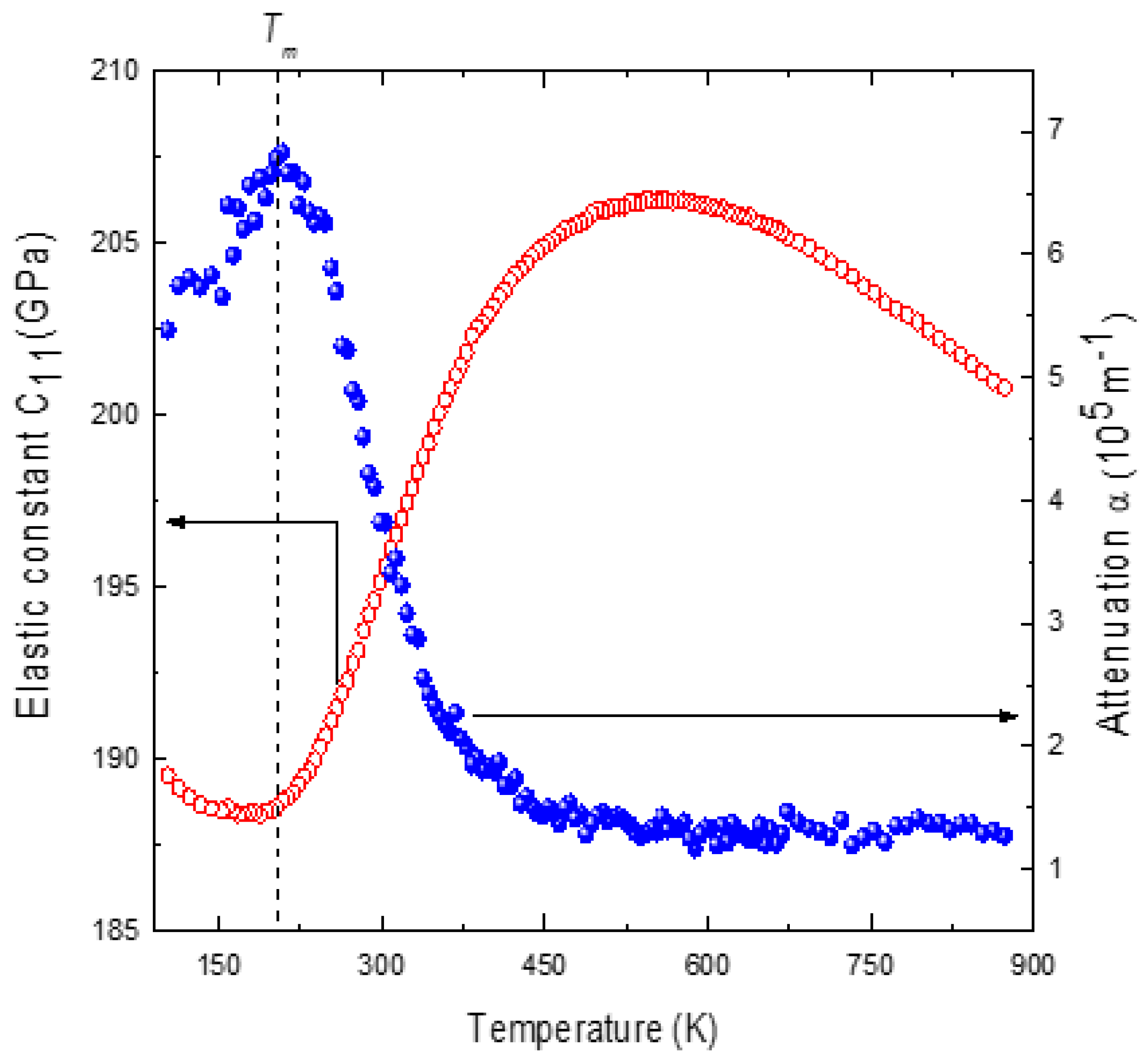
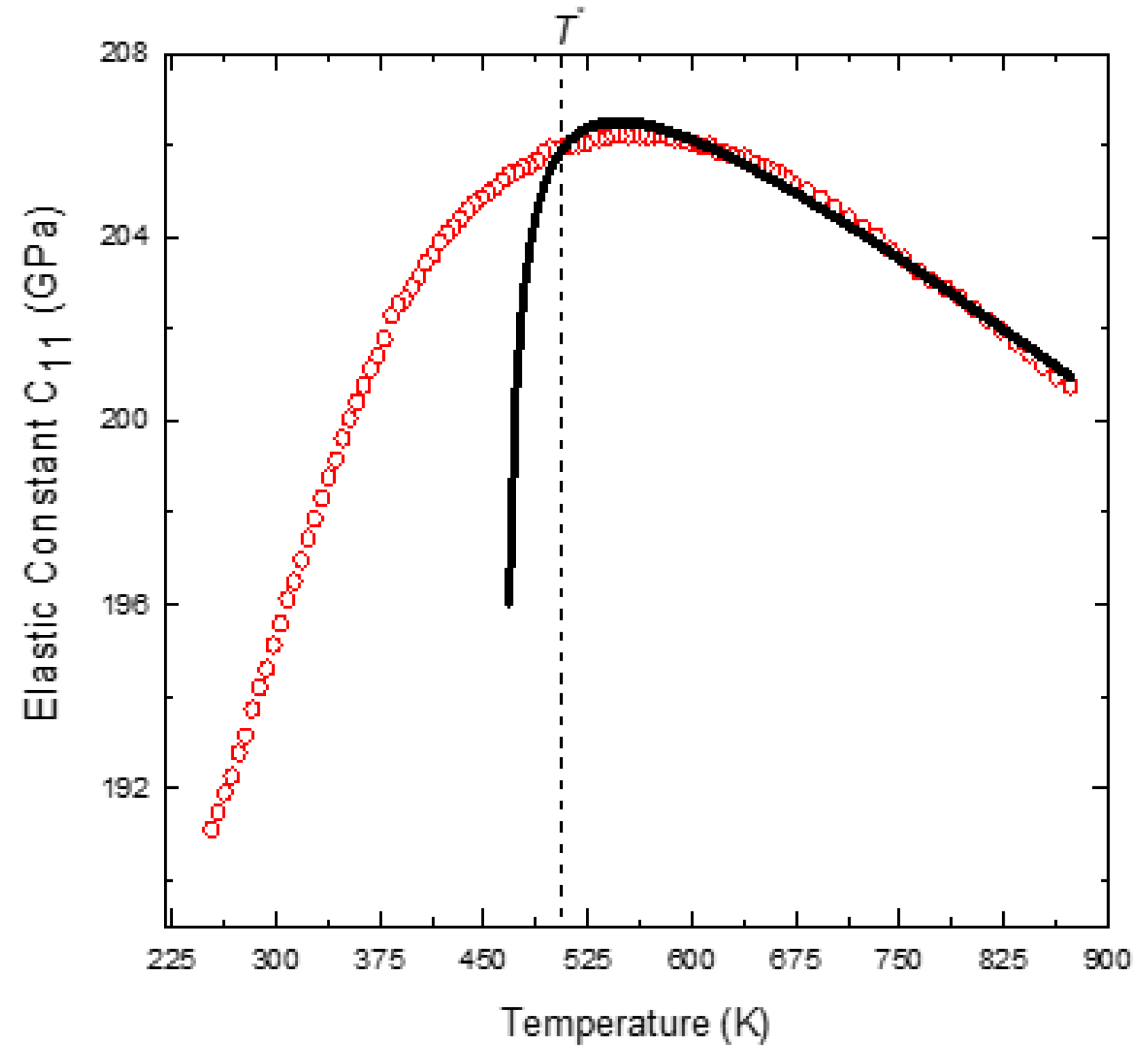
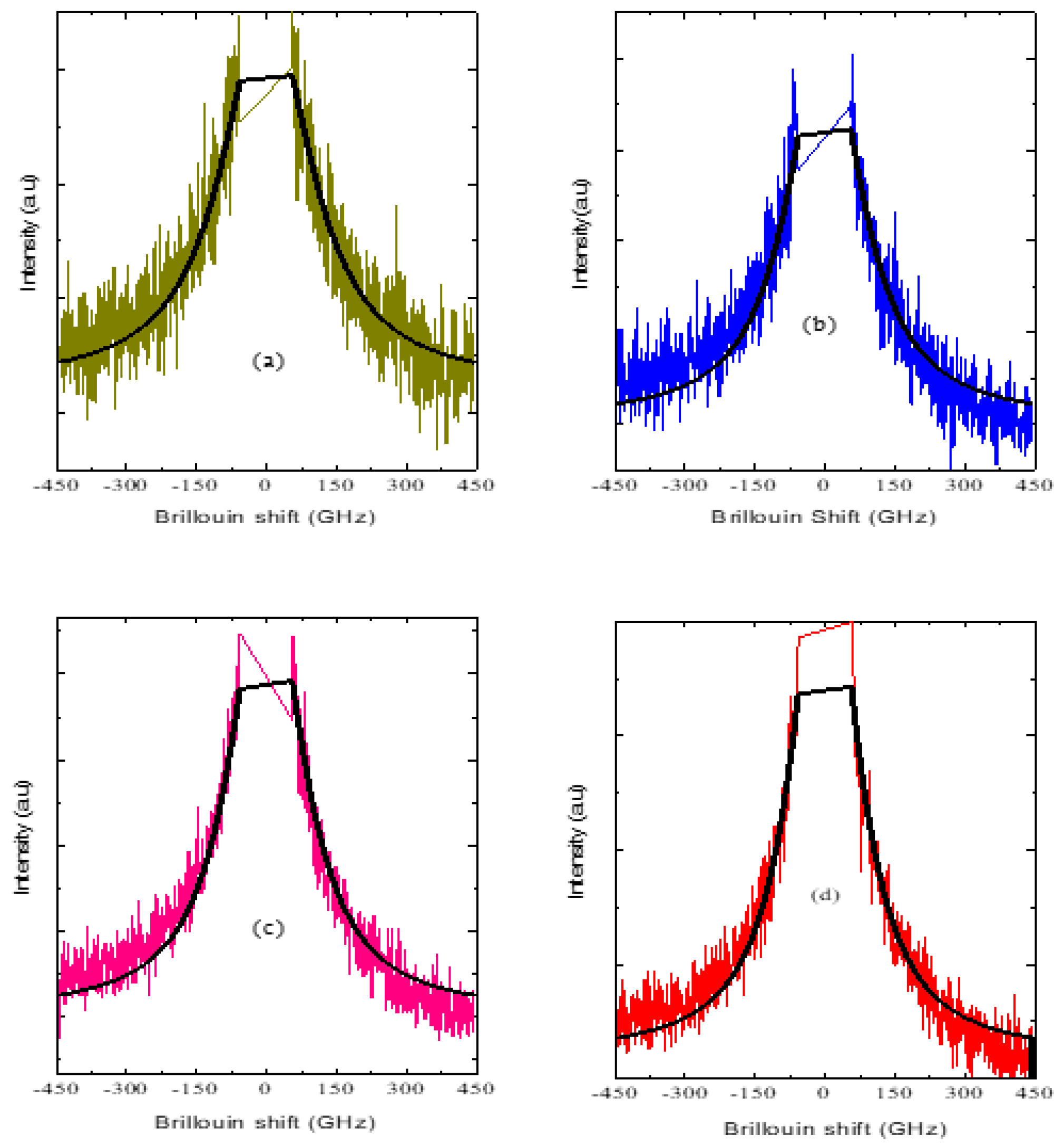
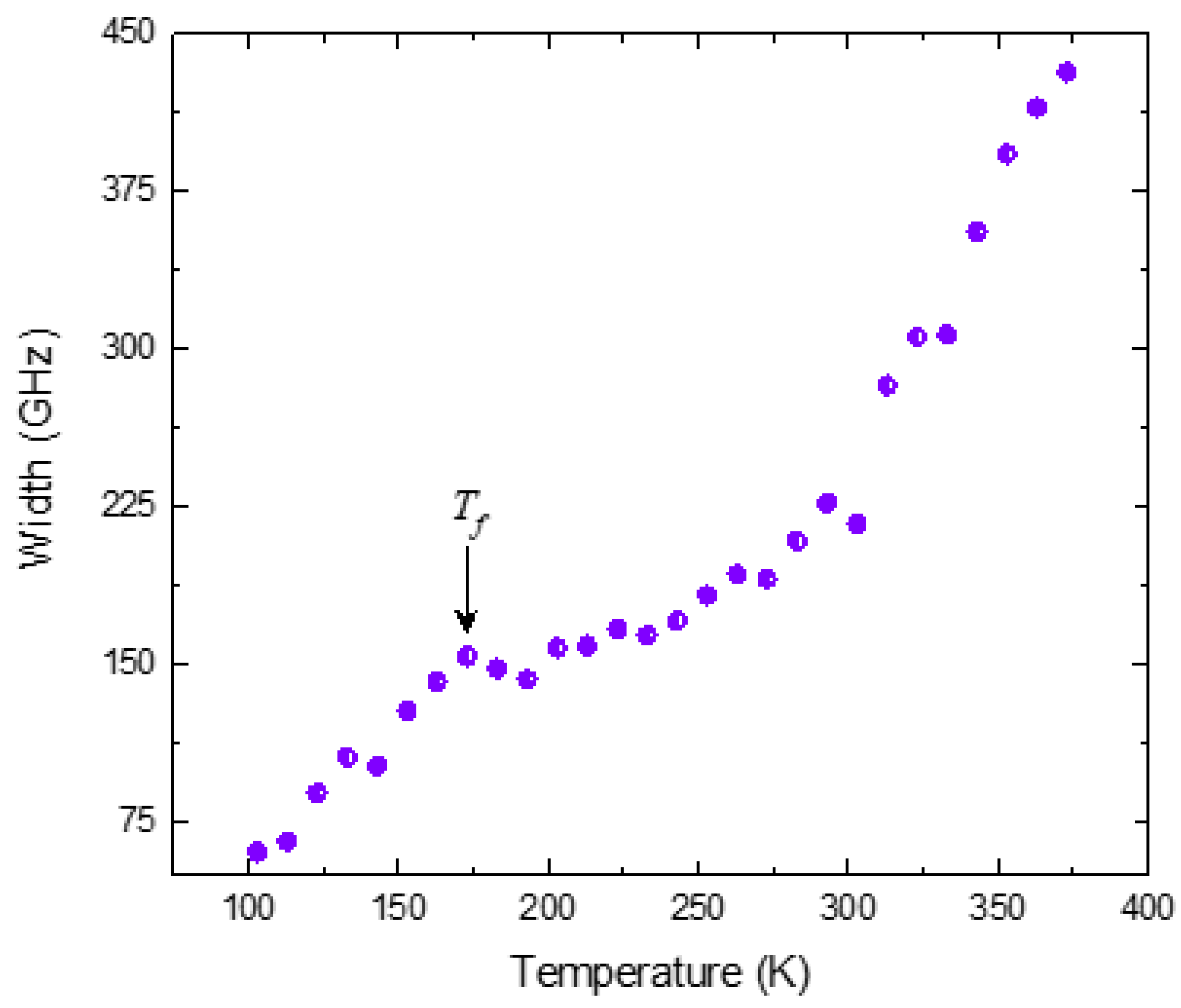
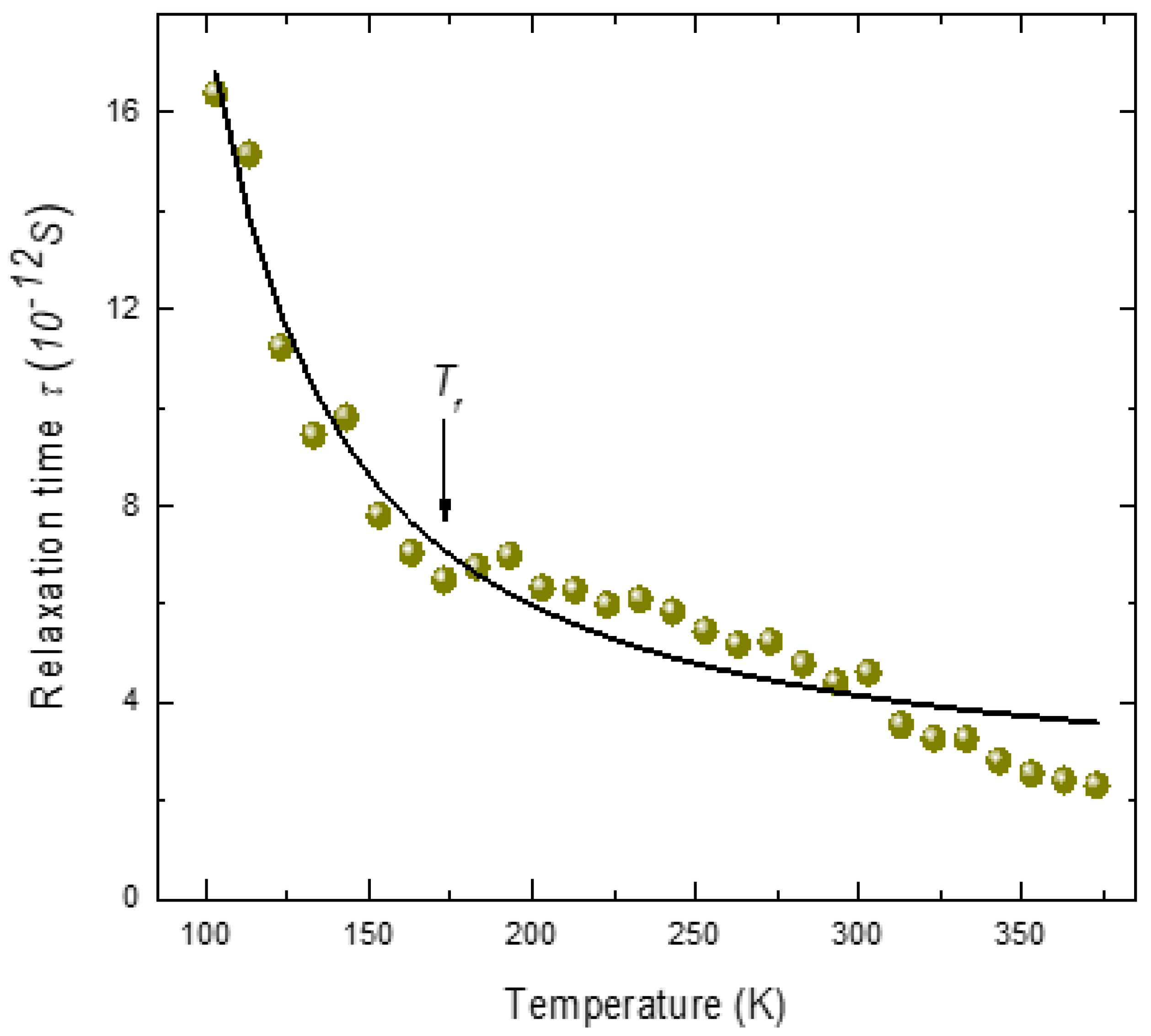
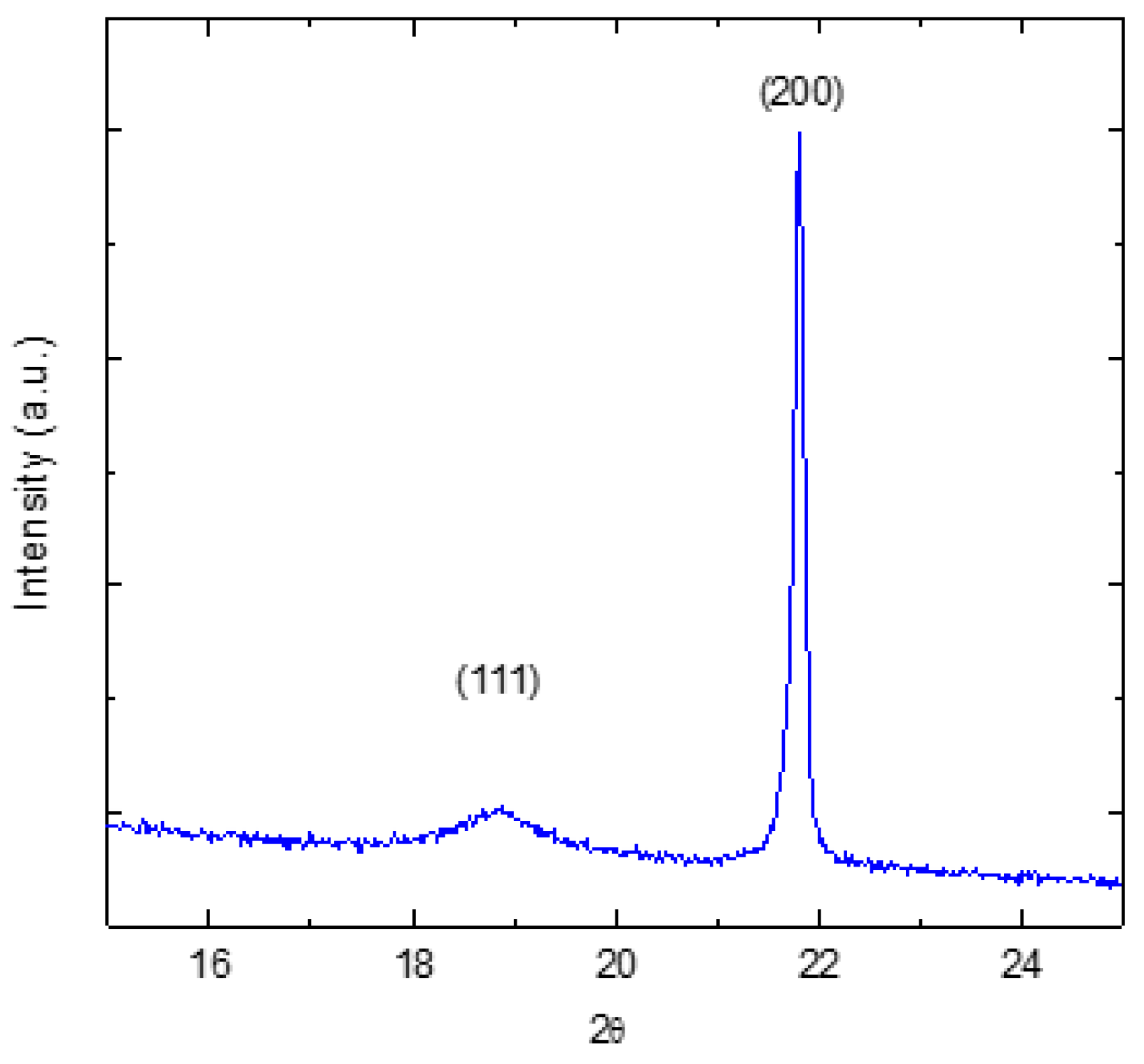
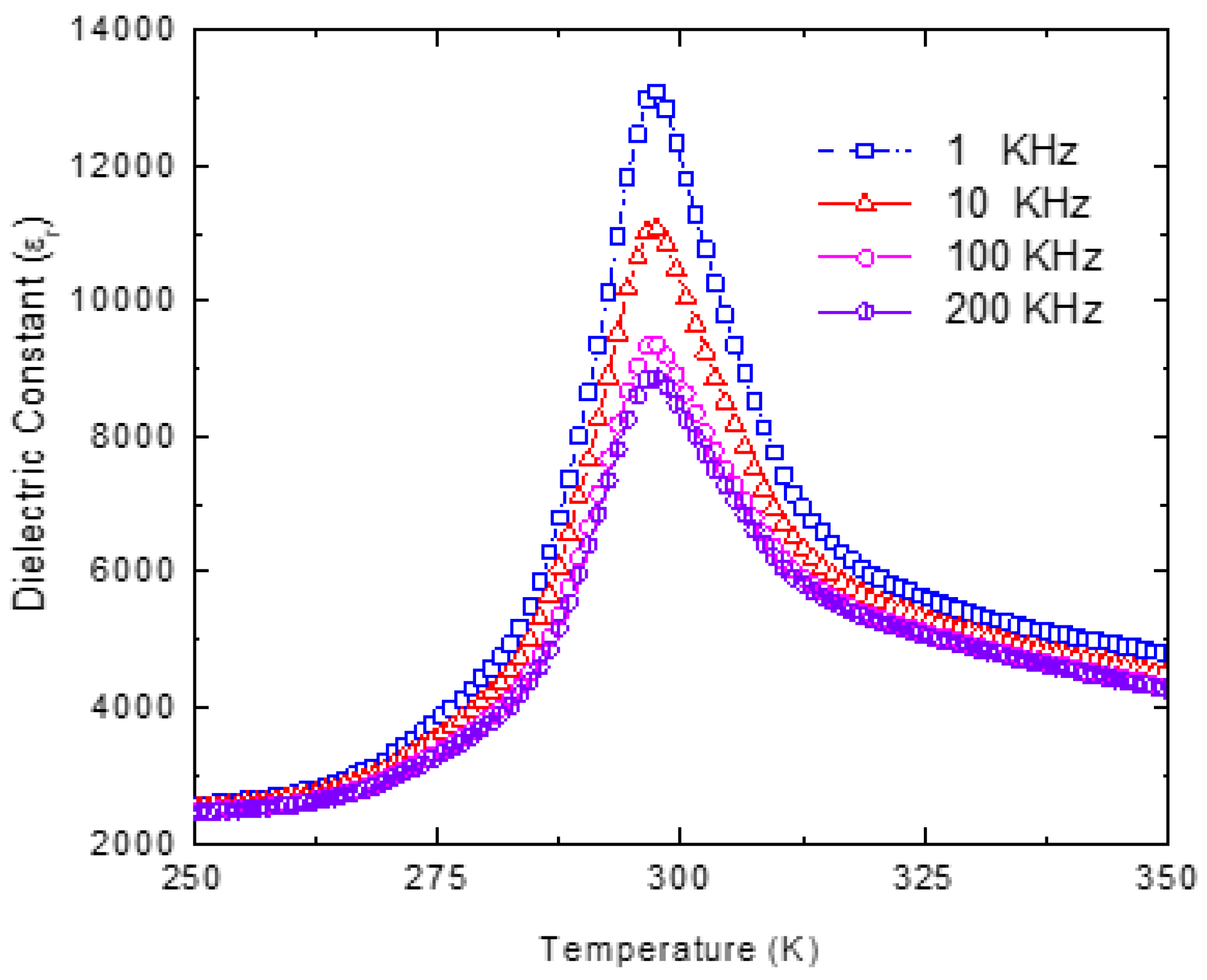
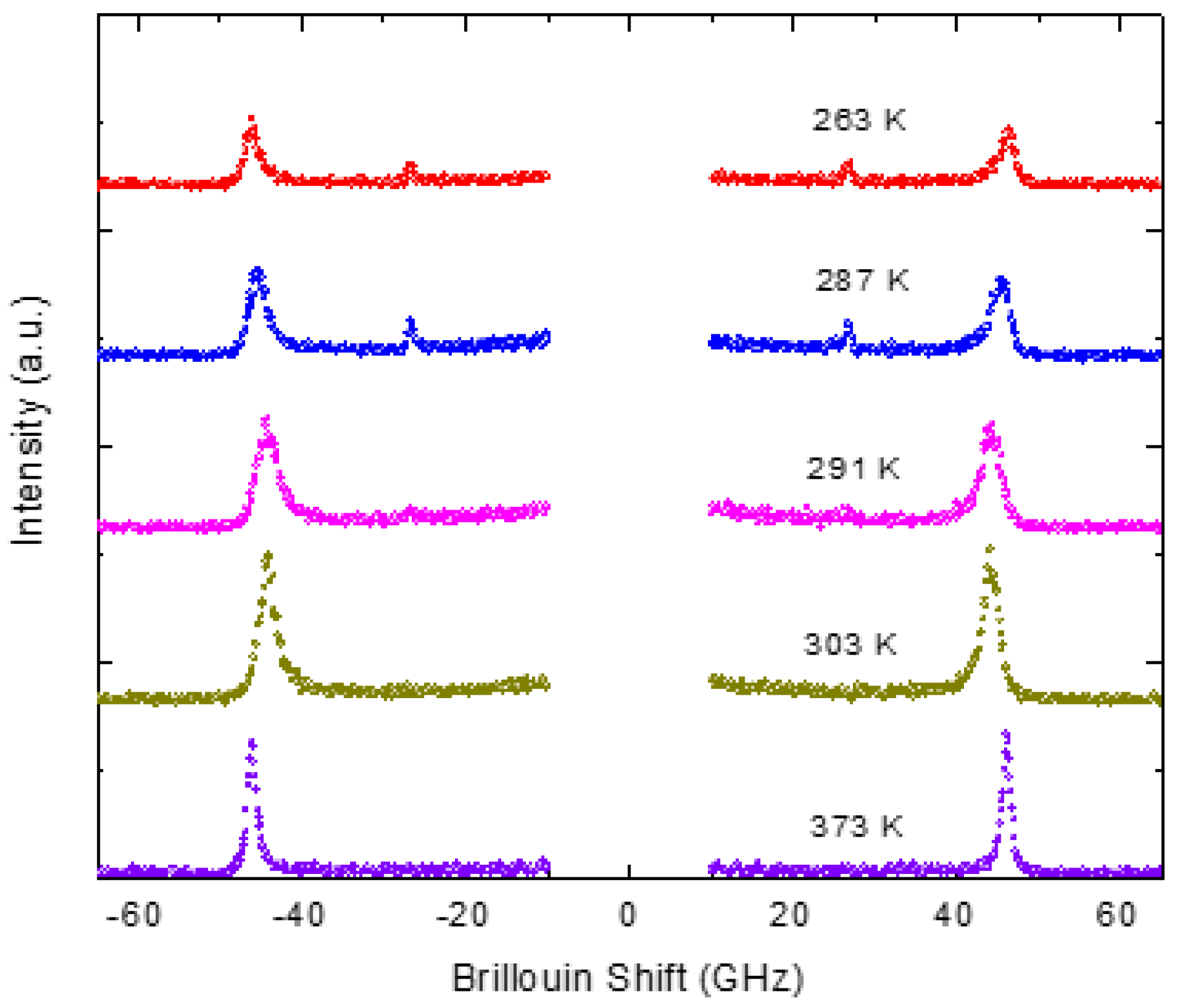
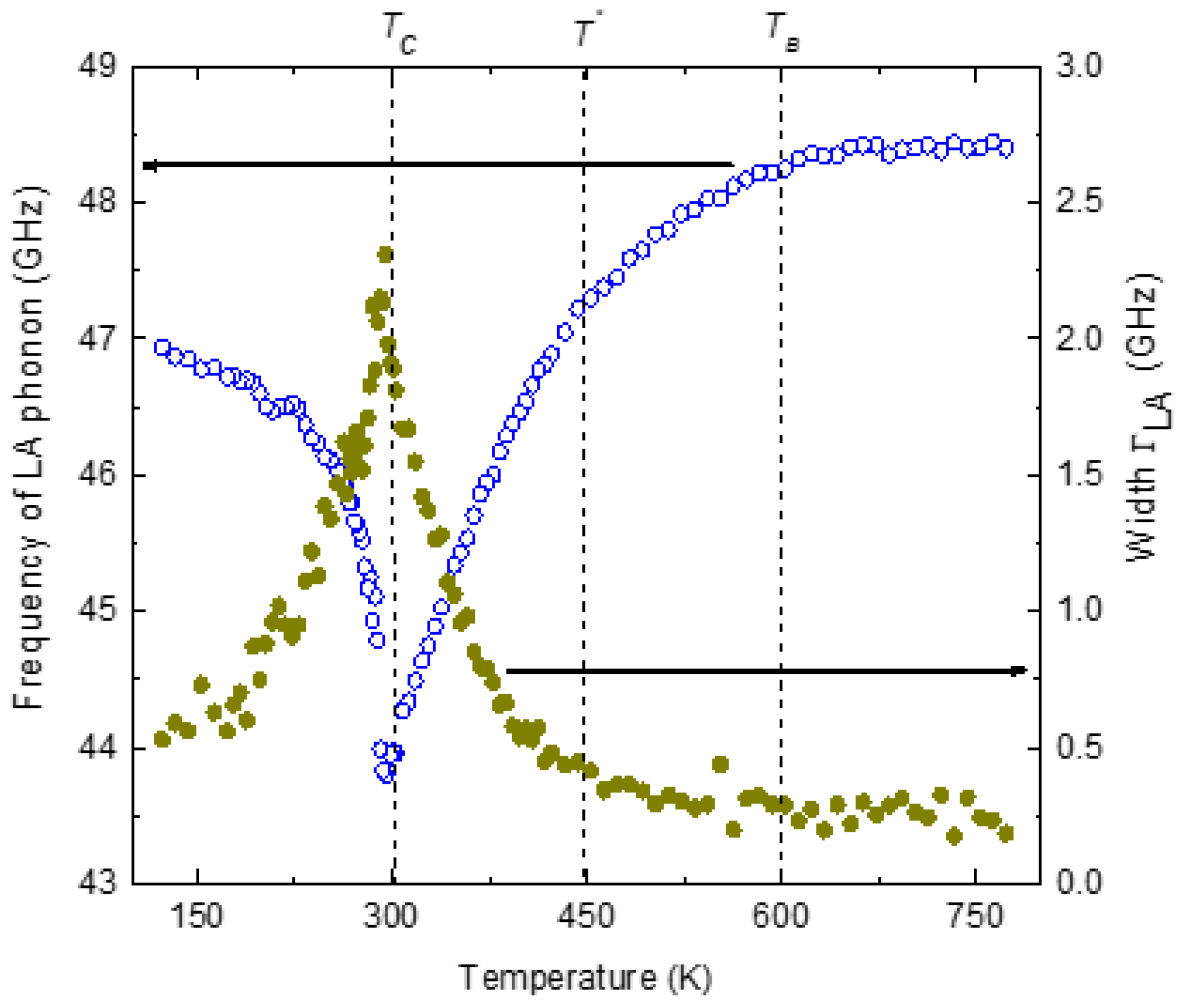

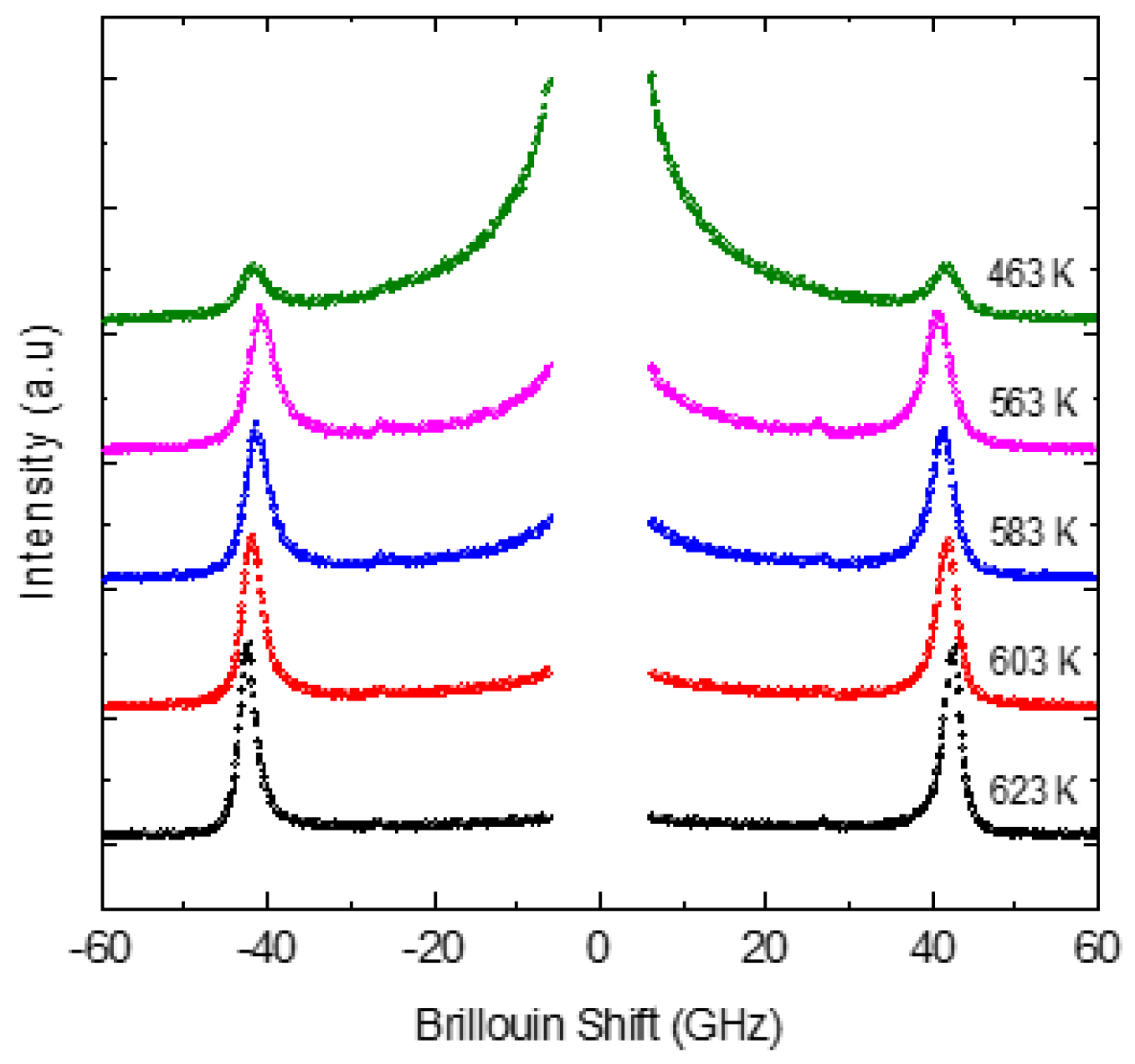

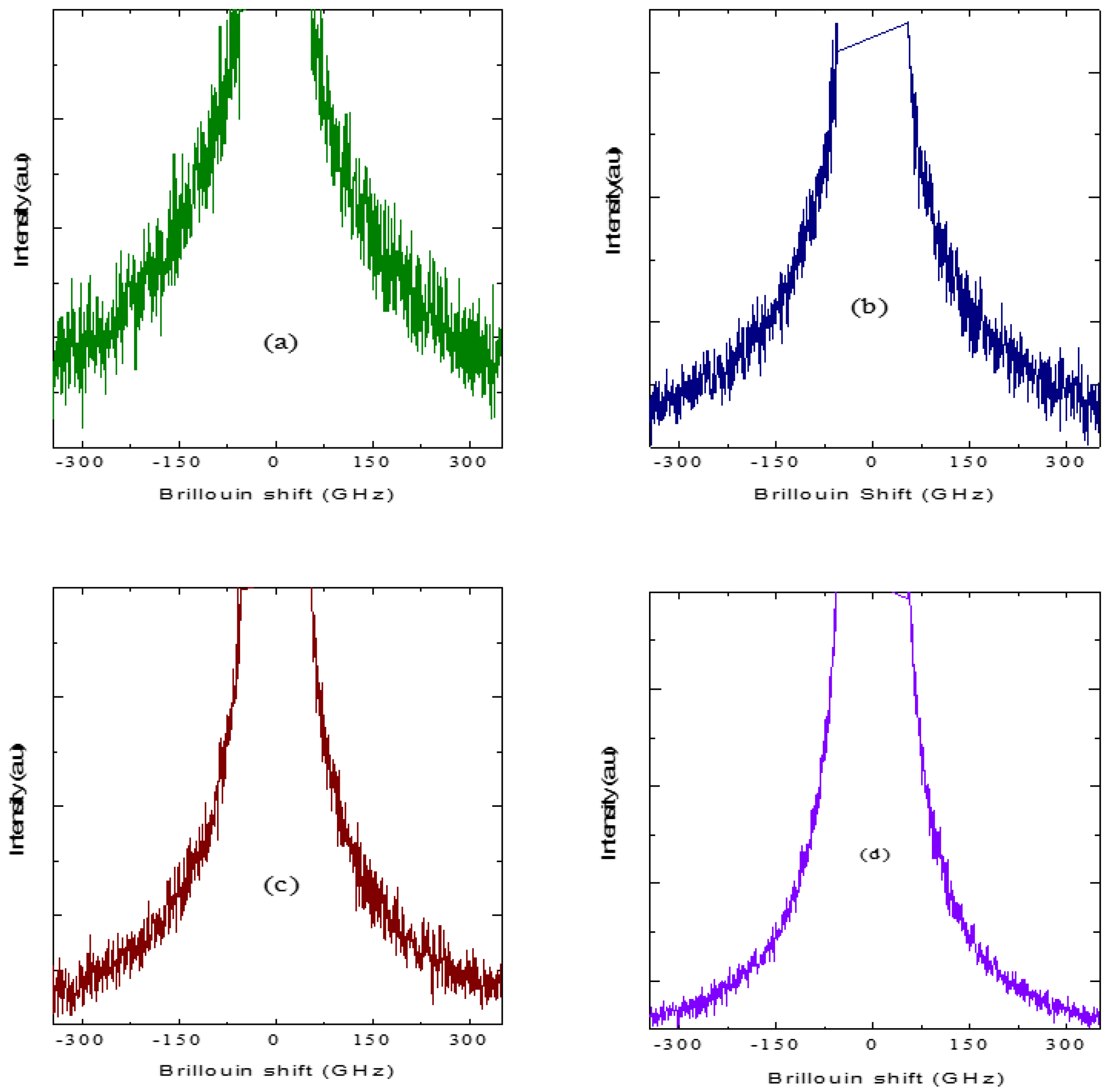
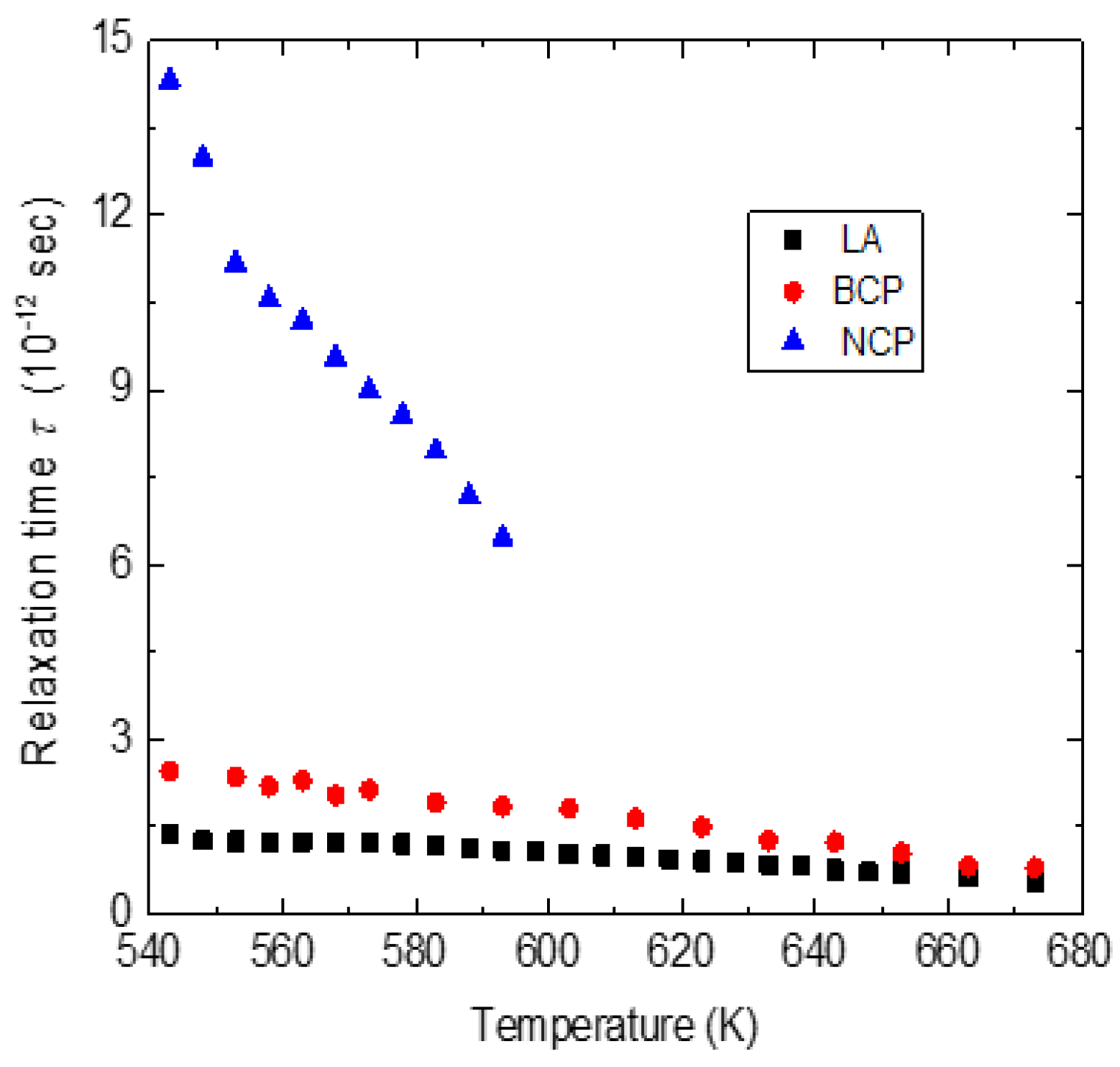
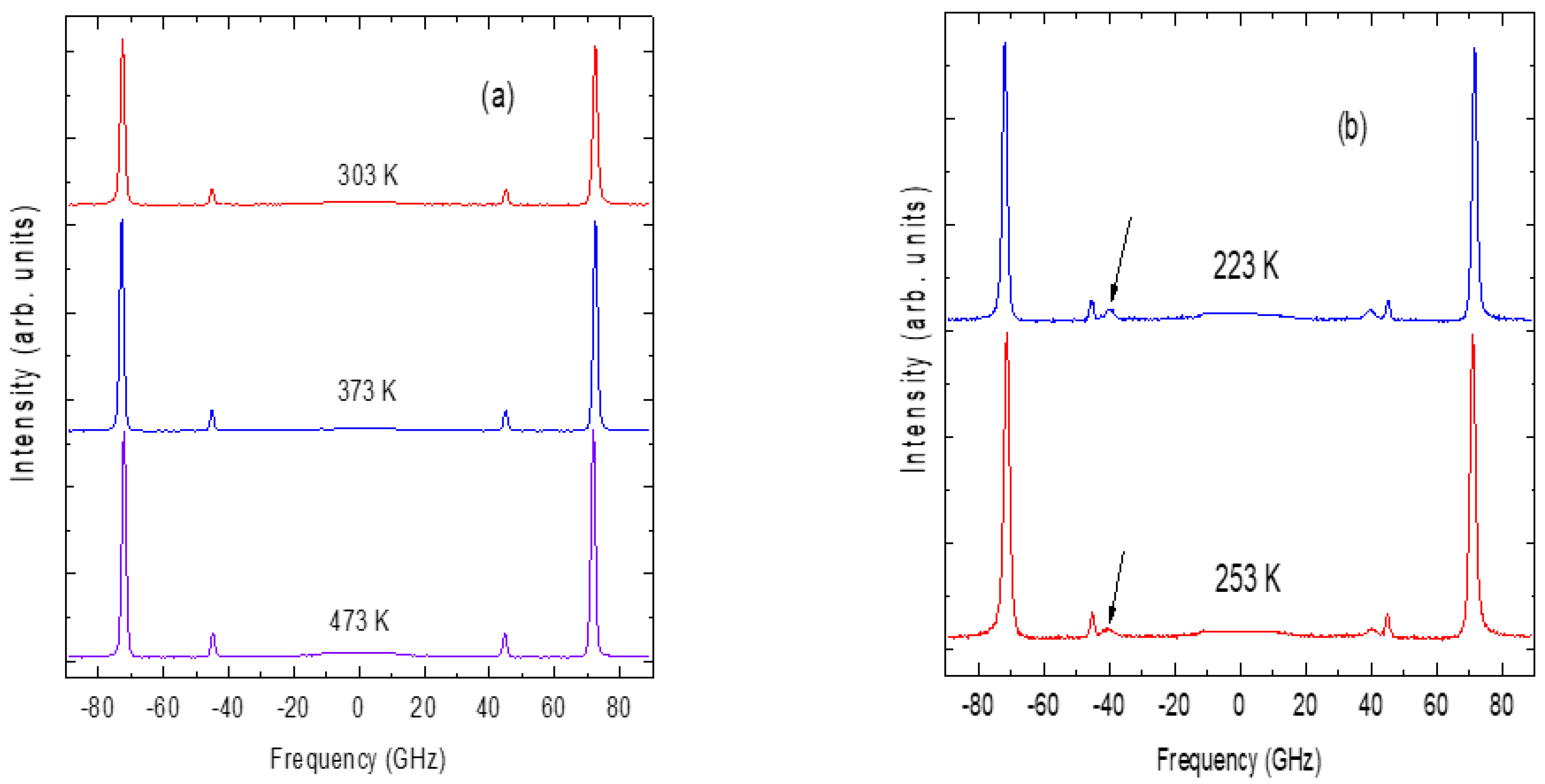
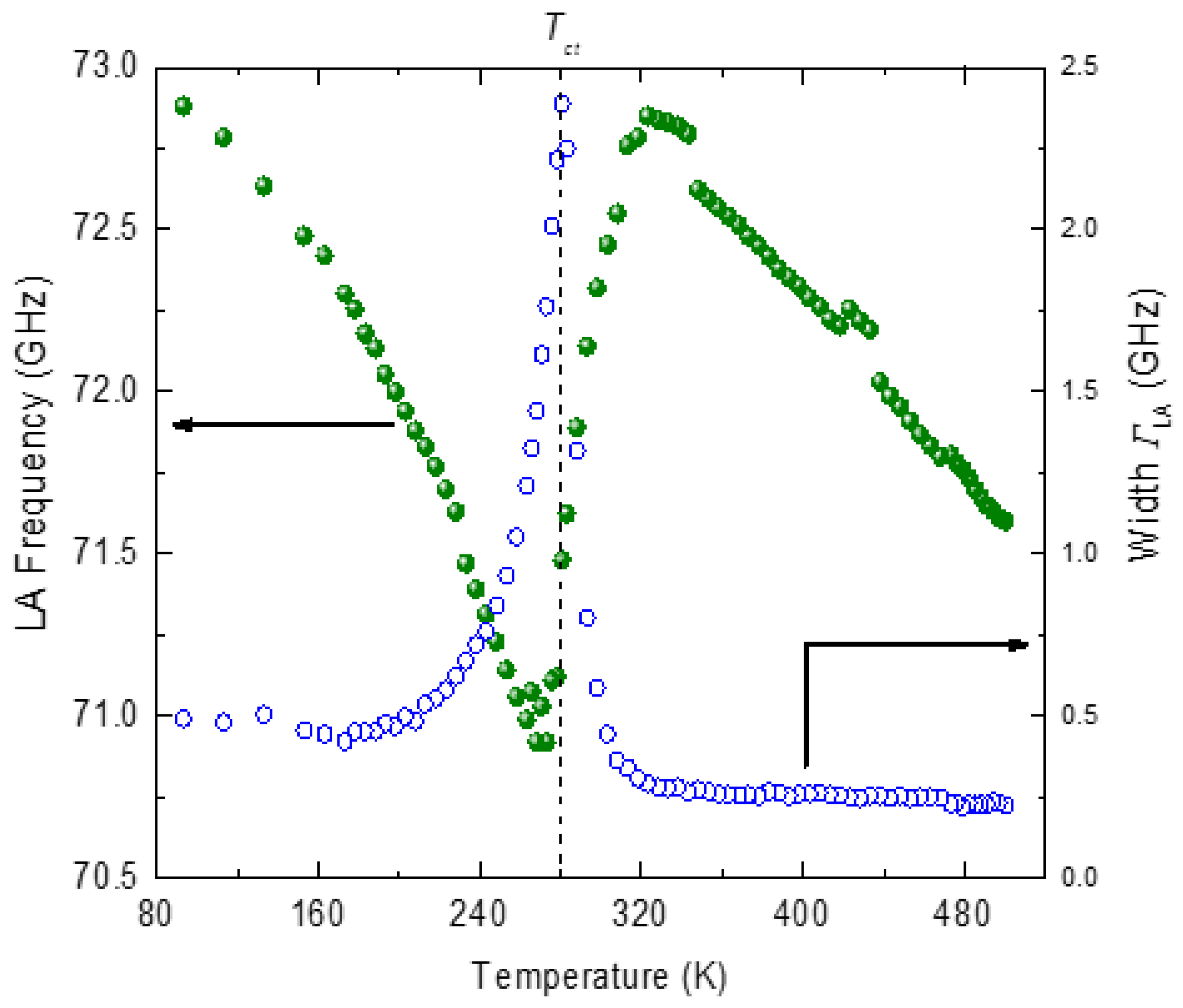
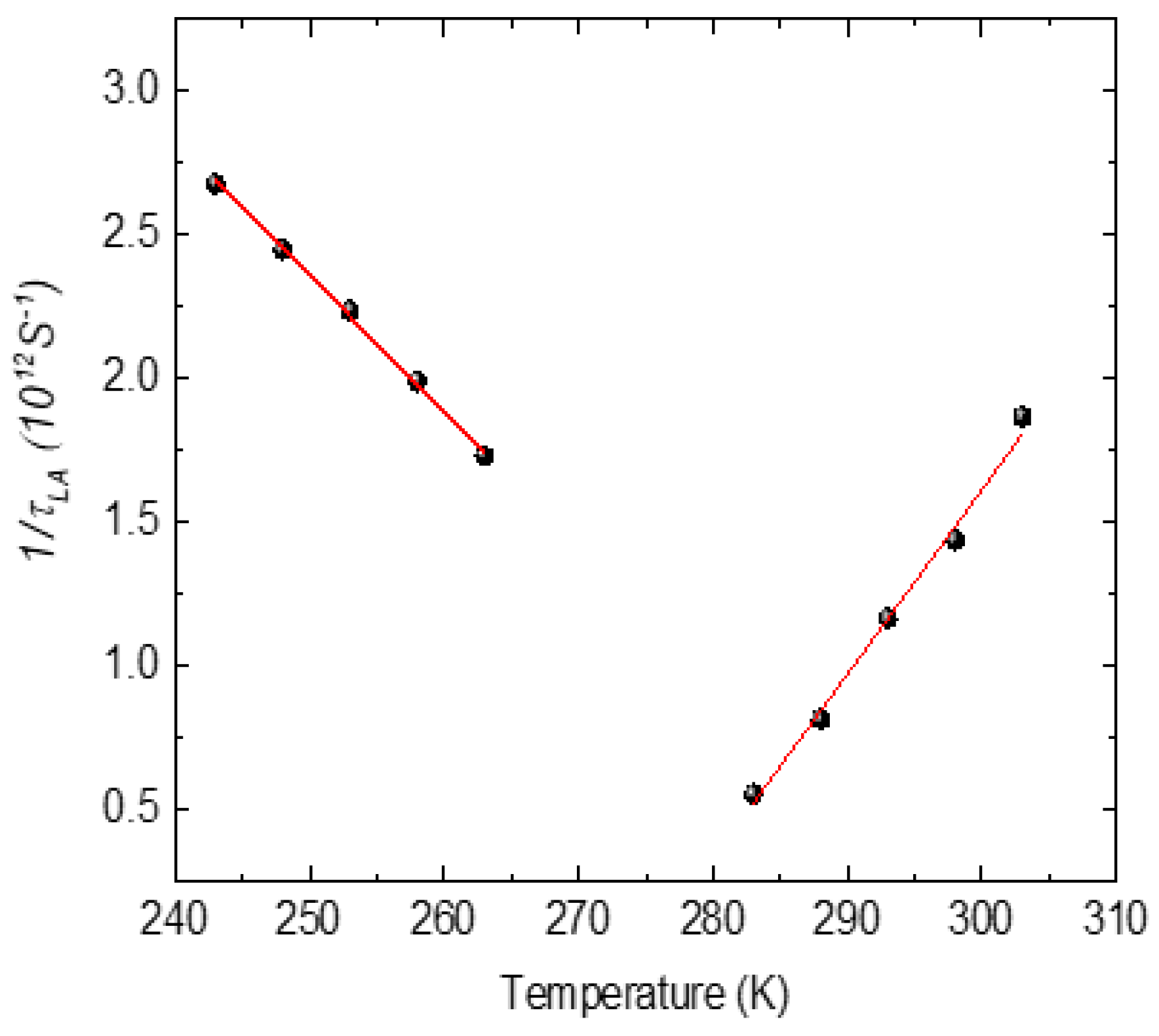
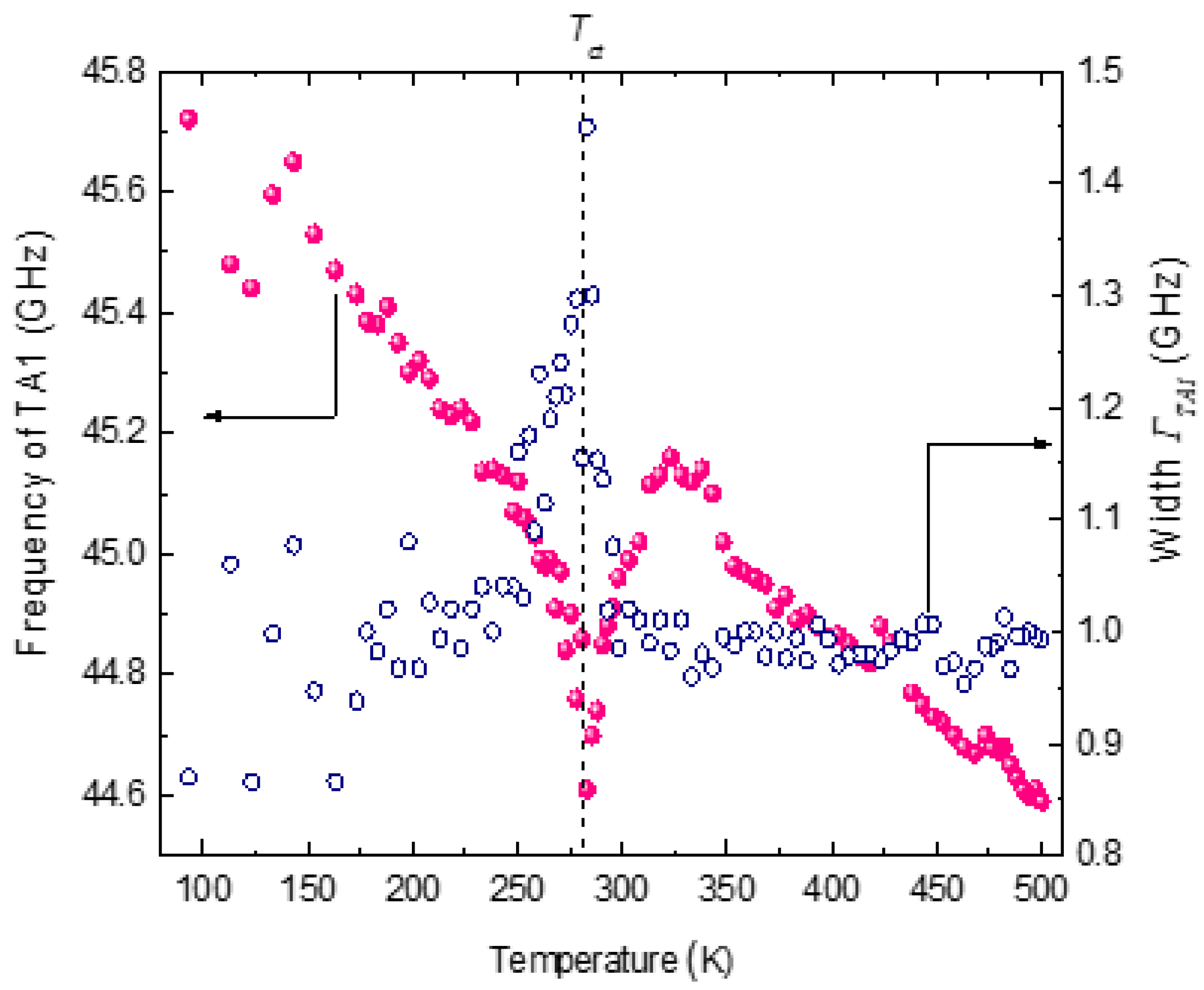
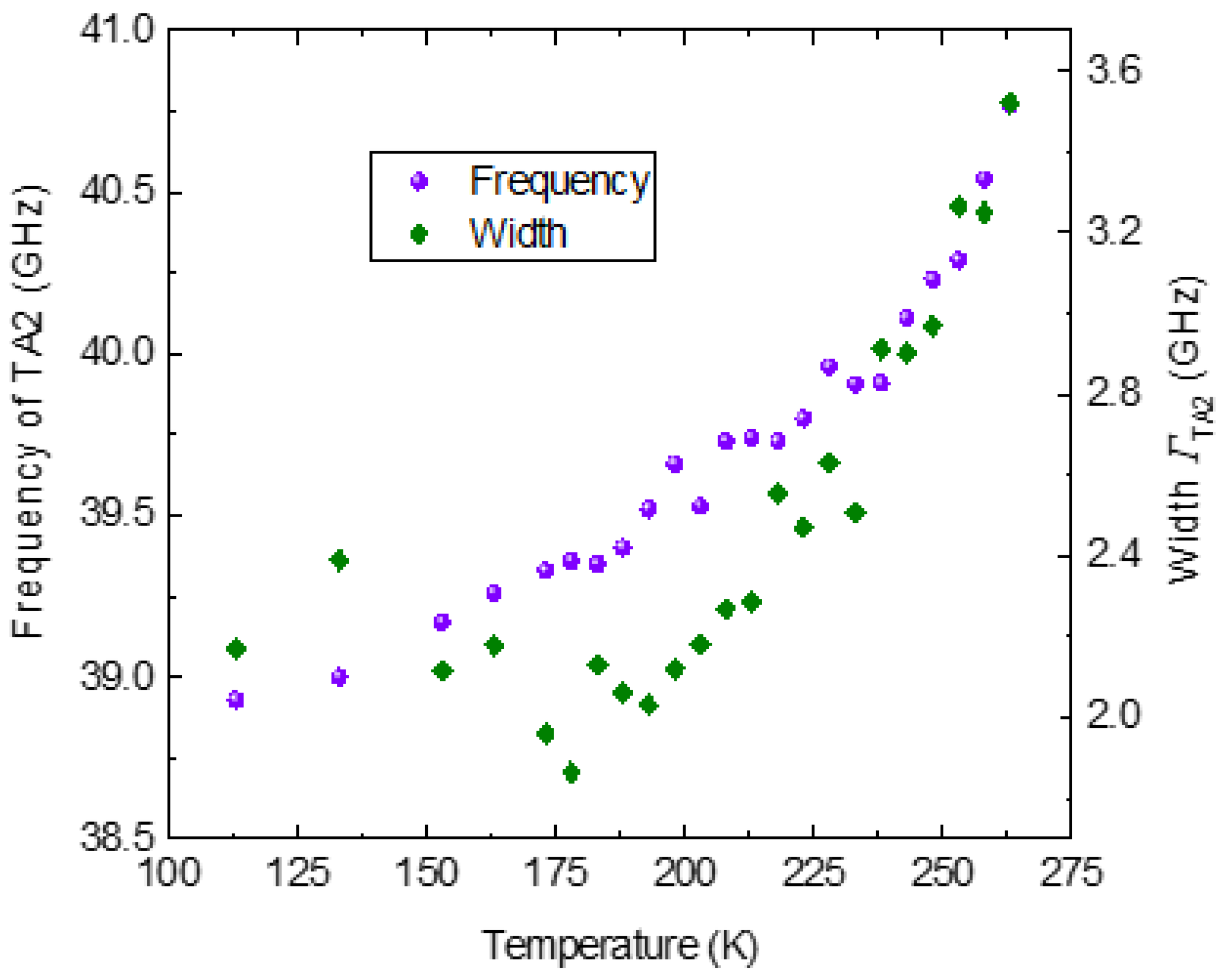
Disclaimer/Publisher’s Note: The statements, opinions and data contained in all publications are solely those of the individual author(s) and contributor(s) and not of MDPI and/or the editor(s). MDPI and/or the editor(s) disclaim responsibility for any injury to people or property resulting from any ideas, methods, instructions or products referred to in the content. |
© 2023 by the authors. Licensee MDPI, Basel, Switzerland. This article is an open access article distributed under the terms and conditions of the Creative Commons Attribution (CC BY) license (https://creativecommons.org/licenses/by/4.0/).
Share and Cite
Sivasubramanian, V.; Ganesamoorthy, S.; Kojima, S. Anomalies of Brillouin Light Scattering in Selected Perovskite Relaxor Ferroelectric Crystals. Materials 2023, 16, 605. https://doi.org/10.3390/ma16020605
Sivasubramanian V, Ganesamoorthy S, Kojima S. Anomalies of Brillouin Light Scattering in Selected Perovskite Relaxor Ferroelectric Crystals. Materials. 2023; 16(2):605. https://doi.org/10.3390/ma16020605
Chicago/Turabian StyleSivasubramanian, Venkatasubramanian, Sarveswaran Ganesamoorthy, and Seiji Kojima. 2023. "Anomalies of Brillouin Light Scattering in Selected Perovskite Relaxor Ferroelectric Crystals" Materials 16, no. 2: 605. https://doi.org/10.3390/ma16020605
APA StyleSivasubramanian, V., Ganesamoorthy, S., & Kojima, S. (2023). Anomalies of Brillouin Light Scattering in Selected Perovskite Relaxor Ferroelectric Crystals. Materials, 16(2), 605. https://doi.org/10.3390/ma16020605






